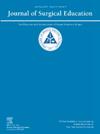没有数字步骤1分数的综合整形外科住院医师申请人的出版趋势
IF 2.1
3区 医学
Q1 EDUCATION, SCIENTIFIC DISCIPLINES
引用次数: 0
摘要
关于第一步评分对综合整形外科住院医师申请人的出版物重要性的影响,我们所知甚少。2024届毕业生是第一批没有数字第一步评分的综合整形外科住院医师。方法于2024年9月对3所最新毕业医学院的555名综合整形外科住院医师进行文献计量分析。数据包括发表数、作者身份、文章类型和期刊质量指标。结果所有居民发表论文的平均数量为7.33篇,各阶层之间保持相对一致。在随后的每个班级中,没有任何出版物的申请人比例从16.9% (PGY-3)下降到15.2% (PGY-2)和9.3% (PGY-1)。同样,没有第一作者发表的匹配申请人从PGY-3和PGY-2类的37.1%和38%下降到PGY-1类的29.5%。此外,没有在整形外科杂志上发表文章的应征者的比例也以每年8%的速度稳步下降。与美国毕业生相比,匹配的国际医学毕业生发表的论文数量不成比例地多。排名前20的项目的住院医生发表的论文比排名前20的项目多50%。所有出版物的平均2年影响因子为3.6,在不同类别之间保持相对一致。在整形外科期刊的出版物中,整形与重建外科是最常见的。临床研究文章是最常见的文章类型。结论第1步通过/不通过的过渡并没有显著改变总发表量,但强调了第一作者,整形外科特定的发表,至少有一篇发表。住院医师主任可能越来越多地利用这些指标作为选择的软标准。本文章由计算机程序翻译,如有差异,请以英文原文为准。
Publication Trends of Integrated Plastic Surgery Residency Applicants Without Numeric Step 1 Scores
Introduction
Little is known regarding the impact of the Step 1 score shift on the importance of publications for applicants to integrated plastic surgery residencies. The Class of 2024 represents the first cohort of integrated plastic surgery residents to match without a numeric Step 1 score.
Methods
A bibliometric analysis of 555 integrated plastic surgery residents from the 3 most recent graduating medical school cohorts was conducted in September 2024. Data included publication count, authorship status, article type, and journal quality indicators.
Results
The average number of publications for all residents analyzed was 7.33 and remained relatively consistent between classes. The percentage of applicants matching without any publications declined within each subsequent class, from 16.9% (PGY-3) to 15.2% (PGY-2) and 9.3% (PGY-1). Similarly, matched applicants without a first-author publication decreased from 37.1% and 38% in the PGY-3 and PGY-2 classes to 29.5% in the PGY-1 class. Furthermore, the proportion of applicants matching without a publication in a plastic surgery journal dropped steadily by ∼8% annually. Matched international medical graduates were responsible for a disproportionately greater number of publications than U.S. graduates. Residents at Top-20 programs exhibited 50% more publications than nontop 20 programs. The average 2-year impact factor among all publications was 3.6 and remained relatively consistent between classes. Among publications in plastic surgery journals, Plastic and Reconstructive Surgery was the most common. Clinical research articles were the most common article type analyzed.
Conclusions
The Step 1 pass/fail transition hasn’t significantly changed total publication output but has emphasized first-author, plastic surgery-specific publications, and having at least 1 publication. Residency directors may increasingly be utilizing these metrics as soft criteria for selection.
求助全文
通过发布文献求助,成功后即可免费获取论文全文。
去求助
来源期刊

Journal of Surgical Education
EDUCATION, SCIENTIFIC DISCIPLINES-SURGERY
CiteScore
5.60
自引率
10.30%
发文量
261
审稿时长
48 days
期刊介绍:
The Journal of Surgical Education (JSE) is dedicated to advancing the field of surgical education through original research. The journal publishes research articles in all surgical disciplines on topics relative to the education of surgical students, residents, and fellows, as well as practicing surgeons. Our readers look to JSE for timely, innovative research findings from the international surgical education community. As the official journal of the Association of Program Directors in Surgery (APDS), JSE publishes the proceedings of the annual APDS meeting held during Surgery Education Week.
 求助内容:
求助内容: 应助结果提醒方式:
应助结果提醒方式:


